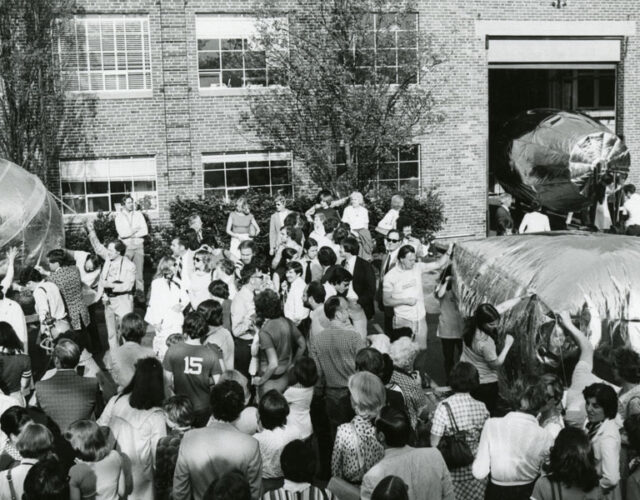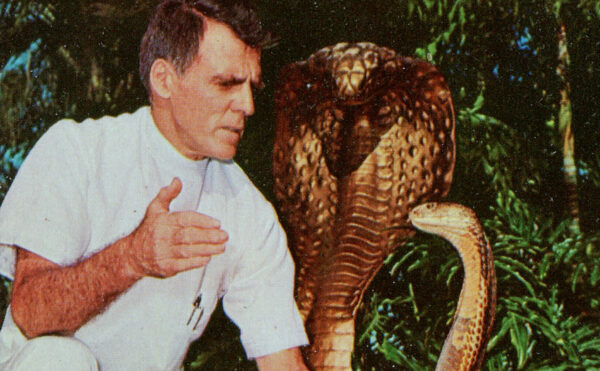If judged by our verbal expressions, we are obsessed with the impossible. Take, for instance, the saying “that went down like a lead balloon.”
The phrase originated in a Mom ’n Pop comic strip written by Loren Taylor in 1924 in which Pop’s stock investment “was about to go up as fast as a lead balloon.” It entered the popular lexicon after World War II and was used to describe anything destined to fail. The rock band Led Zeppelin turned the expression into an ironic name. After all, lead balloons can’t fly, right?
Jim Birkett, a chemist at the consulting firm Arthur D. Little disagreed. While doodling at his desk in 1977 the idea of a lead balloon crossed his mind. After some quick calculations he determined that an extremely thin sphere of lead foil filled with helium would rise as long as it was at least 6 feet in diameter. He organized a company contest to find the best lead-balloon designs and set a launch date for the competition. The highest flyer would win.
Birkett’s inspiration did not materialize out of thin air. Arthur D. Little’s eponymous founder had upended a similar expression in 1921 when he challenged the company’s chemists to create a “silk” purse from a sow’s ear. That adage had existed since at least 1738, when it was popularized by Jonathan Swift’s Polite Conversation. The Boston-based company believed that scientific progress had left Swift’s expression by the wayside.
Building on advances in the synthetic-fiber industry, Arthur D. Little had 100 pounds of sows’ ears reduced to glue, which the company’s chemists then dissolved, filtered, and finally turned into fiber. The “silk” fiber was woven into two small purses that resemble the kind used by French nobility in the Middle Ages. Today one purse is stored at the National Museum of American History, while the other is at the Massachusetts Institute of Technology.
This playful accomplishment motivated Birkett to disprove an idiom that no longer fit with the scientific world of the 1970s. After receiving a number of submissions, he settled on three promising balloon designs that attempted to account for the frailty of lead foil with inventive ways of inflating and supporting the balloons. One team proposed wrapping a rubber weather balloon filled with helium in lead foil, then slowly deflating the rubber interior while inflating the space between the rubber and the lead. Another team offered a lead-foil cube that would unfold like origami as it inflated. The final design was closer to a zeppelin than a balloon, consisting of lead foil covering a cylindrical wooden frame. All three designs were large, rivaling the size of a car.
On the evening of May 16, 1977, the teams unveiled their finished products in front of staff, journalists, and a film crew. But soon they all ran into trouble. The origami cube was brought out first and connected to the helium. As the cube unfolded, the bottom ripped. Team members patched it on the fly, and it rose about 20 feet into the air. But the wind that night was stronger than anticipated, and a powerful breeze reopened the patched tears and forced the balloon to the ground.
The team with the weather-balloon design kept filling their leaky construction with helium until the moment of launch. Birkett later recounted that “partly by accident but one suspects not entirely,” a gust of wind forced the ropes out of the hands of its team. To everyone’s amusement the balloon rolled up a tree and, never gaining much height, drifted about a mile away.
The zeppelin crew members, who had already filled their balloon, removed a support pipe running through it and used drawstring to close the holes “like a pair of pajama bottoms,” Birkett remembers. But before they could finish, a gust of wind snapped the balloon’s tethers. Cheered by onlookers, it soared into the sky and disappeared beyond the horizon—in the direction of Logan Airport. Alarmed, Birkett called the airport’s control tower and warned of an incoming aircraft. “You’re not going to believe this, but there is a lead balloon heading your way,” he remembers saying. “And they said, ‘yes we do believe it because we’re watching it on television.’” The balloon was last seen by an inbound commercial airliner; it was drifting east toward Europe. Birkett had proven the lead-balloon expression wrong, and the zeppelin design was declared the clear winner.
Looking back from the perspective of 2015, Birkett says of the competition, “If there’s anything from my professional life that I would have on my gravestone, it might be the lead balloon. It was a serendipitous dream come true—I couldn’t replicate it and I wouldn’t try; the pieces all just came together.”
As to the fate of the escaped lead balloon, no one knows. In his more speculative moments Birkett imagines it slowly sinking into the Atlantic, only to be discovered by a Soviet nuclear sub and taken to the Soviet Union where scientists puzzle over its purpose, suspecting it to be an infernal capitalist weapon.
Not much of consequence was gained from Birkett’s contest, but it showed that with a little math and a lot of lead foil the impossible can be made possible. In many ways the lead balloon and the silk purse were philosophical statements—and publicity stunts—designed to inspire.
More than 30 years after Birkett’s contest, the television show Mythbusters tried a similar stunt by flying a lead balloon like the origami cube. More recently, software engineer Rob Rhinehart tackled the notion that “man cannot live on bread alone.” While technically that adage may still hold true, Rhinehart imagines his Soylent (a name that may sound familiar to movie buffs) as an all-in-one “staple meal” that might replace traditional food. Through crowd funding and venture capital, the company raised $4.5 million dollars and began shipping Soylent (which is beige in color, not green) to customers in 2014.
Our thanks to Jim Birkett for sharing the story of the lead balloon with us.




